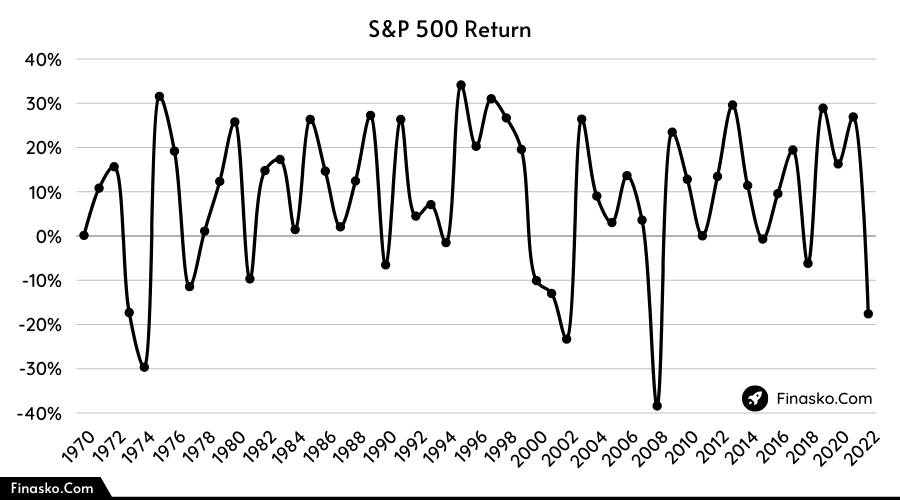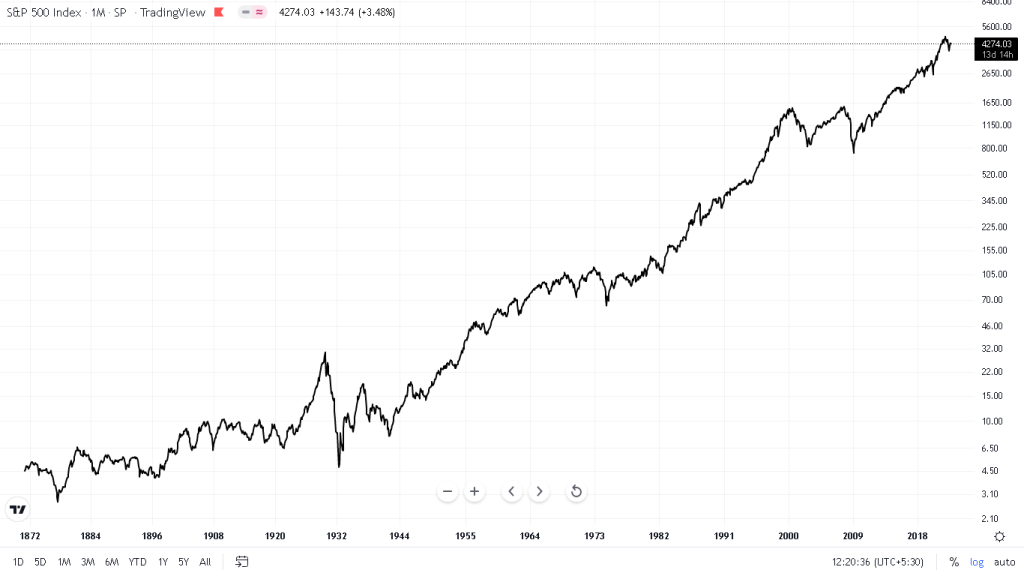Sp 500 Continuous Compounded Daily Returns Histogram

| S&P 500 (SPX) | DATA |
| Index Founded | 1957 |
| Total Stock | 505 |
| YTD Return | -17.66% |
| Market Cap | $36.70 Trillion |
| Biggest Gain | 38.06% (1958) |
| Biggest Fall | -38.49% (2008) |
| Data Updated | 02 Sep 2022 |
One of the most popular equity indices, theStandard & Poor's Index,was created in 1926 to reflect the performance of the top 500 largest companies in the US Stock Market. In the last 95 years (1926 – 2022) the S&P 500 Historical Annual Return is around 10% to 11% , and 7% inflation-adjusted returns based on historical data.
If we calculate return by day then – $1000 Invested in the SPX 500 during Jan of 1990, it would have grown to nearly $25,752 by the End of 2021 (Dividends Reinvested).
S&P 500 Return By Month (2022)
| Month | Return |
| Jan 2022 | -5.26% |
| Feb 2022 | -3.14% |
| Mar 2022 | 3.58% |
| Apr 2022 | -8.80% |
| May 2022 | 0.01% |
| June 2022 | -8.39% |
| July 2022 | 9.11% |
| Aug 2022 | -4.24% |
S&P 500 Annual Return By Year (1928 to 2022)
In the below chart you easily can check theHistorical Annual Return of the S&P 500 index (Price Return) from 1928 to 2022 –
SPX Historical Price Chart (1880-2022)

In this table, you can see the Performance of the S&P 500 with the opening price, and the closing price:-
| Year | Opening Price | Closing Price |
|---|---|---|
| 2022 | 4,778.14 | |
| 2021 | 3,700.65 | 4,793.06 |
| 2020 | 3,257.85 | 3,756.07 |
| 2019 | 2,510.03 | 3,230.78 |
| 2018 | 2,695.81 | 2,506.85 |
| 2017 | 2,257.83 | 2,673.61 |
| 2016 | 2,012.66 | 2,238.83 |
| 2015 | 2,058.20 | 2,043.94 |
| 2014 | 1,831.98 | 2,058.90 |
| 2013 | 1,462.42 | 1,848.36 |
| 2012 | 1,277.06 | 1,426.19 |
| 2011 | 1,271.87 | 1,257.60 |
| 2010 | 1,132.99 | 1,257.64 |
| 2009 | 931.80 | 1,115.10 |
| 2008 | 1,447.16 | 903.25 |
| 2007 | 1,416.60 | 1,468.36 |
| 2006 | 1,268.80 | 1,418.30 |
| 2005 | 1,202.08 | 1,248.29 |
| 2004 | 1,108.48 | 1,211.92 |
| 2003 | 909.03 | 1,111.92 |
| 2002 | 1,154.67 | 879.82 |
| 2001 | 1,283.27 | 1,148.08 |
| 2000 | 1,455.22 | 1,320.28 |
| 1999 | 1,228.10 | 1,469.25 |
| 1998 | 975.04 | 1,229.23 |
| 1997 | 737.01 | 970.43 |
| 1996 | 620.73 | 740.74 |
| 1995 | 459.11 | 615.93 |
| 1994 | 465.44 | 459.27 |
| 1993 | 435.38 | 466.45 |
| 1992 | 417.26 | 435.71 |
| 1991 | 326.45 | 417.09 |
| 1990 | 359.69 | 330.22 |
| 1989 | 275.31 | 353.40 |
| 1988 | 255.94 | 277.72 |
| 1987 | 246.45 | 247.08 |
| 1986 | 209.59 | 242.17 |
| 1985 | 165.37 | 211.28 |
| 1984 | 164.04 | 167.24 |
| 1983 | 138.34 | 164.93 |
| 1982 | 122.74 | 140.64 |
| 1981 | 136.34 | 122.55 |
| 1980 | 105.76 | 135.76 |
| 1979 | 96.73 | 107.94 |
| 1978 | 93.82 | 96.11 |
| 1977 | 107.00 | 95.10 |
| 1976 | 90.90 | 107.46 |
| 1975 | 70.23 | 90.19 |
| 1974 | 97.68 | 68.56 |
| 1973 | 119.10 | 97.55 |
| 1972 | 101.67 | 118.05 |
| 1971 | 91.15 | 102.09 |
| 1970 | 93.00 | 92.15 |
| 1969 | 103.93 | 92.06 |
| 1968 | 96.11 | 103.86 |
| 1967 | 80.38 | 96.47 |
| 1966 | 92.18 | 80.33 |
| 1965 | 84.23 | 92.43 |
| 1964 | 75.43 | 84.75 |
| 1963 | 62.69 | 75.02 |
| 1962 | 70.96 | 63.10 |
| 1961 | 57.57 | 71.55 |
| 1960 | 59.91 | 58.11 |
| 1959 | 55.44 | 59.89 |
| 1958 | 40.33 | 55.21 |
| 1957 | 46.20 | 39.99 |
| 1956 | 45.16 | 46.67 |
| 1955 | 36.75 | 45.48 |
| 1954 | 24.95 | 35.98 |
| 1953 | 26.54 | 24.81 |
| 1952 | 23.80 | 26.57 |
| 1951 | 20.77 | 23.77 |
| 1950 | 16.66 | 20.41 |
| 1949 | 14.95 | 16.76 |
| 1948 | 15.34 | 15.20 |
| 1947 | 15.20 | 15.30 |
| 1946 | 17.25 | 15.30 |
| 1945 | 13.33 | 17.36 |
| 1944 | 11.66 | 13.28 |
| 1943 | 9.84 | 11.67 |
| 1942 | 8.89 | 9.77 |
| 1941 | 10.48 | 8.69 |
| 1940 | 12.63 | 10.58 |
| 1939 | 13.08 | 12.49 |
| 1938 | 10.52 | 13.21 |
| 1937 | 17.02 | 10.55 |
| 1936 | 13.40 | 17.18 |
| 1935 | 9.51 | 13.43 |
| 1934 | 10.11 | 9.50 |
| 1933 | 6.83 | 10.10 |
| 1932 | 7.82 | 6.89 |
| 1931 | 15.85 | 8.12 |
| 1930 | 21.18 | 15.34 |
| 1929 | 24.81 | 21.45 |
| 1928 | 17.76 | 24.35 |
Is S&P 500 a good investment?
The S&P 500 (SPX) is an index of the 500 largest companies in the U.S., weighted by market capitalization – Including many large, brand-name companies like Alphabet (Google), JPMorgan Chase, Amazon, Exxon Mobil, Tesla, and Apple.
According to a 2020 report, over 15 years, nearly 90% of actively managed investment funds failed to beat the index funds or market. It is a safe & diversified investment that has historically kept it secure from too much market fluctuation and provides great returns in long run.
Also, many experts say that beginner or individual investors can start an investment gurney with S&P 500 Index Funds and improve their portfolio's stability.
S&P 500 Vs. Nasdaq 100
No doubt that the Nasdaq 100 Return outperformed the S&P 500 and Dow Jones Performance, but you can see in the below chart that the risk is also increased with the reward –
What Affects the S&P 500 Returns?
Generally, there 3 things that can affect the SPX/Stock Market Returns –
#1 Inflation: Investors can use historical data to identify How Inflation Affects The Stock Market. When comparing the actual returns against nominal returns, investors can see how inflation reduces returns. Instead of being 10% of the average return, the CPI-adjusted average return falls to 7%.

#2 Timing: You've decided to invest in stocks and ETFs. That's an important step, but your investment strategy has one more thing to consider: timing and entry points affect the returns. A new study shows that the best timings make up 50% more profit.
For Example – An investor who bought between 2017 and 2019 and sold in the 2020 (Covid) recession has experienced a bad performance, but those who invest or average during the market bottom have great portfolio returns.
A re We In A Recession? Check Out In 1-Minute
The Question is How to Identify the Best Time to Enter In the Stock Market?
So for that, you can use a few market valuation indicators like S&P 500 PE Ratio, Buffet Indicator, and Shiller PE Ratio. That helps investors & traders understand whether the stock market is undervalued or overvalued.
#3 Capital Gain Tax: Usually, if you bought any stock or etf and sell with profit under 12 months period then you will be eligible for short-term capital gain tax, which is normally higher than Long-term capital gains tax rates. So think about long-term investment, you can take help from this article "How to Pay Less" and understand how you can save more.
FAQ's
Q. S&P 500 Annual Returns Last 10 Years?
The SP 500's past 10 years return is almost 15% and 11.58% for the last 5 years. Speaking of returns over last 100-year average return is around 10%–11%, with inflation-adjusted returns of 7%.
Q. Does the S&P 500 Index Pay Dividend?
Yes. Many companies in the index provide dividends, you can find out by index dividend yield. And if you want to know which companies pay regular dividends then you can track dividend aristocrats and dividend kings.
Q. How to Invest in S&P 500 Index?
The best way to invest in an Index is S&P 500 ETF (Exchange Trade Fund). They have a low expense ratio, the same return as an index, and are tradable like stocks. But before choosing any instrument to invest in S&P 500, make sure you know the pros and cons of each method because these instruments have their advantages and demerits.
Disclaimer ✋
The information included on this site is for educational purposes only and is not intended to be a substitute for investment advice. Data on past performance, where given, is not necessarily a guide to future performance. So before investing you should carefully consider the Fund's investment objectives, risks, charges, and expenses.
Source: https://finasko.com/sp-500-returns/
0 Response to "Sp 500 Continuous Compounded Daily Returns Histogram"
إرسال تعليق